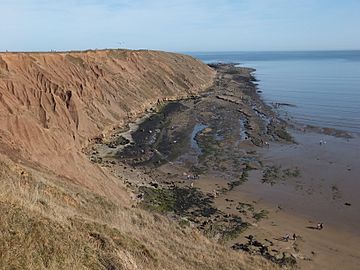Filey Brigg facts for kids
Quick facts for kids Filey Brigg |
|
|---|---|

Filey Brigg: Carr Naze seen from Filey Brigg Country Park
|
|
| Highest point | |
| Geography | |
| Location | North Yorkshire, England |
Filey Brigg is a cool, long, narrow piece of land that sticks out into the sea. You can find it about a mile north of Filey in North Yorkshire, England. Its cliffs are about 20 metres (65 feet) high. These cliffs are made of different kinds of rock, like sandstone and limestone.
The part of Filey Brigg closest to the land is called Carr Naze. The long, rocky part that goes out into the sea is simply known as the Brigg. In the 1970s, the fields on top of the Brigg became Filey Brigg Country Park. Because of its special plants, animals, and rocks, Filey Brigg is a protected area called a Site of Special Scientific Interest.
Contents
A Look Back in Time: Roman History
The story of Filey Brigg's past began in 1857. A local historian named Dr. Cortis started digging there. He found an old Roman signal station!
Roman Discoveries
In November 1857, Dr. Cortis gave a talk about his findings. He mentioned that a painter from Filey, named Wilson, had found many Roman items. These included pottery, bones, and burnt wood. These were found near Carr Naze, on the northern side of Filey Bay.
These discoveries led to more digging. Five large stones were uncovered. People thought they might have been altars or bases for pillars. One stone even had a carving of a dog chasing a deer! Dr. Cortis also reported finding a piece of an inscription near one of the stones.
The Roman Watchtower
More investigations happened in 1920. Experts then believed the five stones found by Dr. Cortis were the foundations of a wooden watchtower. Sadly, you can't see any remains of it today. This is because the cliffs have worn away over time.
It's thought that the Roman signal station was built in the late 300s AD. It was likely left or raided around 400 AD. Today, you can see the five stones in the Filey Crescent Gardens.
Nature's Story: Rocks and Wildlife
Filey Brigg and Filey Bay were formed by a cool geological event. The rock on the south side of the Brigg slid down. This caused the clay above it to drop to sea level. The sea then wore away the clay, creating Filey Bay.
The hard rock on the northern side stayed put. This is what forms the Brigg that sticks out into the sea. The area is still changing! Large rock slides have happened because the clay cliffs of Carr Naze are always eroding. A big one happened in 1869. It took away hundreds of metres of the Naze.
Birds of the Brigg
The rocks of Filey Brigg are a great place for many birds. The area between the tides is especially popular. You can spot birds like oystercatchers, redshanks, and purple sandpipers. These birds visit the shoreline in large numbers during the winter months.
Fun Stories: Local Legends
People have told two interesting stories about how Filey Brigg was formed. These are old legends passed down through generations.
The Devil's Work
One legend says that the Devil built the long ridge of rocks. The story goes that he lost his hammer in the sea. When he reached for it, he grabbed a fish instead! The Devil shouted, "Hah! Dick!" This is supposedly how the fish, a haddock, got its name. Since then, Filey Brigg is said to have the marks of the Devil's grip on its shoulders.
The Dragon's Bones
Another legend tells of a dragon that caused trouble in the area. But the clever townsfolk outsmarted it! The dragon dived into the sea to wash some parkin (a type of Yorkshire cake) from its teeth. While it was in the water, the townsfolk drowned it. The legend says that the rocks of Filey Brigg are actually the bones of this dragon!

